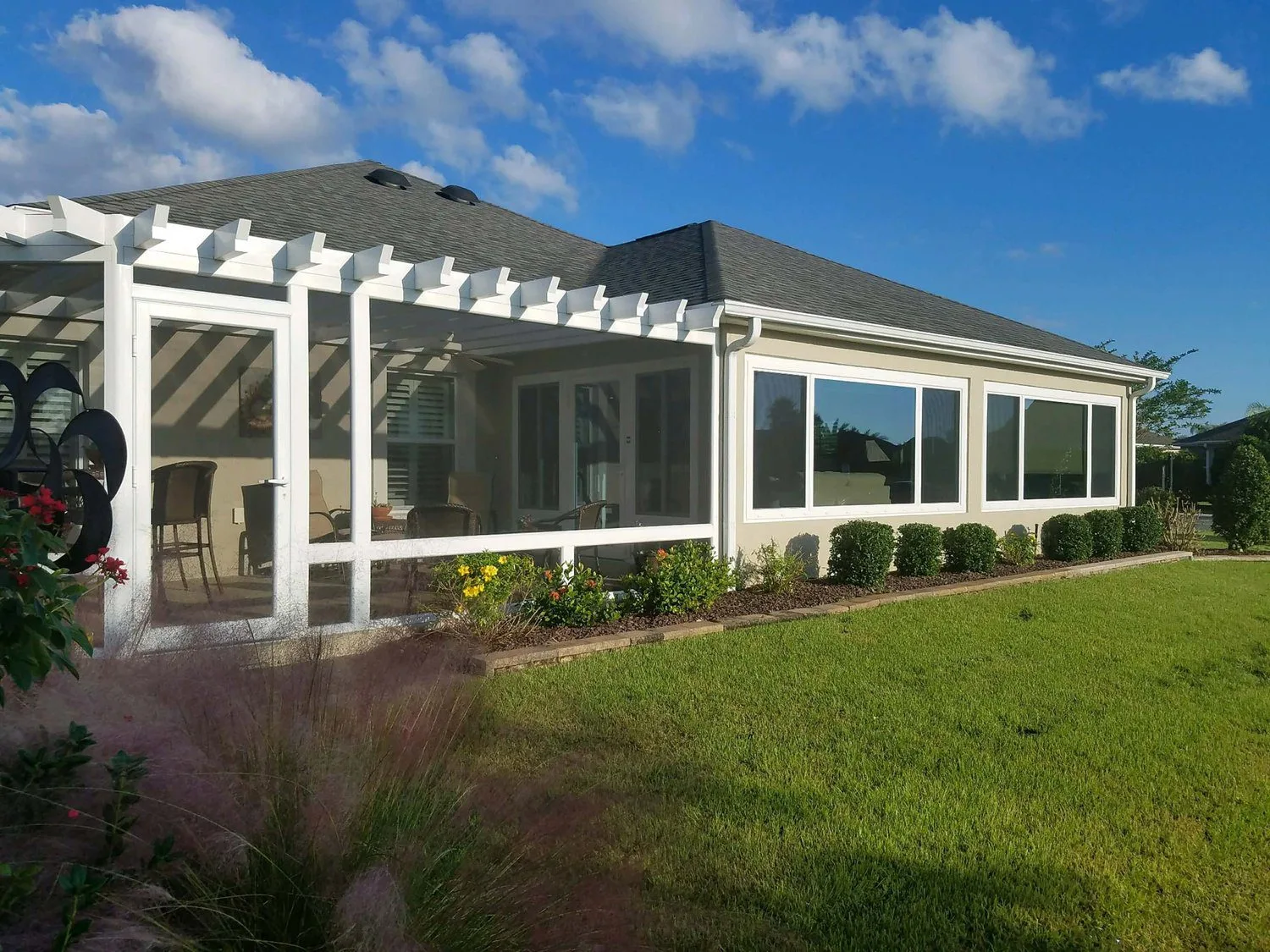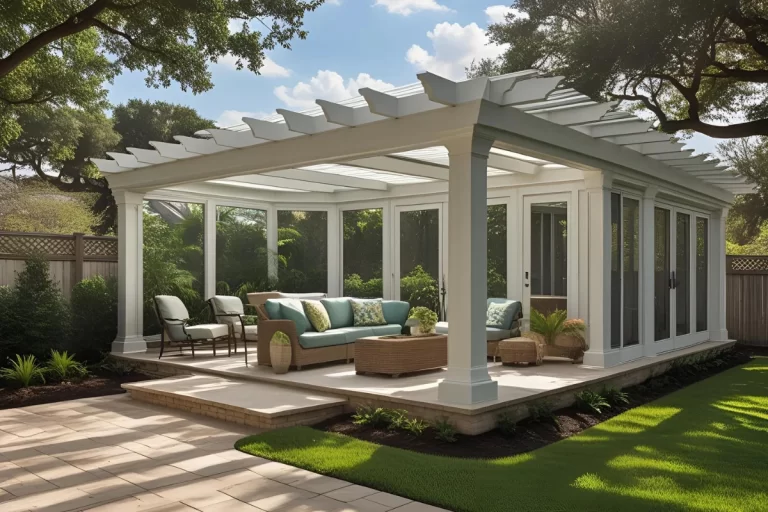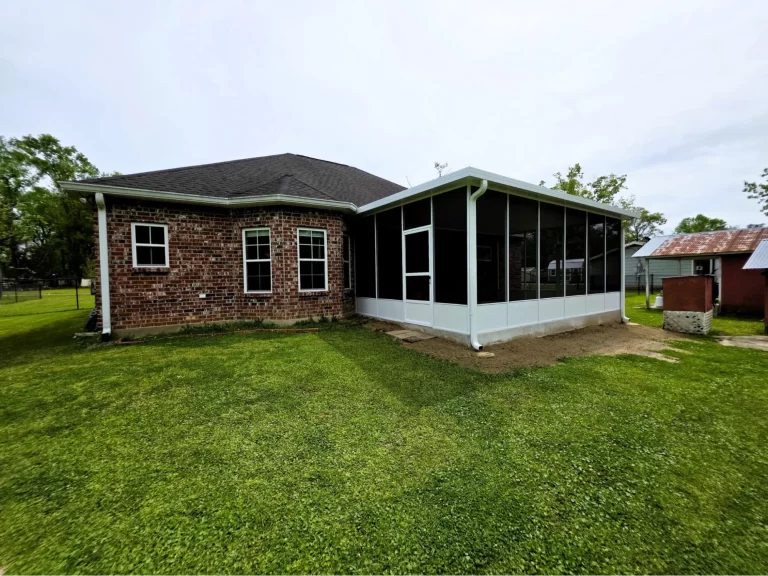Adding a sunroom is one of the smartest ways to enjoy more space and sunlight at home. In New Orleans, where the weather is warm, rainy, and humid for much of the year, a sunroom lets you enjoy the outdoors without bugs, heat, or sudden showers.
Whether you want a quiet reading spot, a bright area to gather with family, or a place to watch the rain roll in, this guide will walk you through everything you need to know—from types of sunrooms and local permits to choosing the right contractor for your project.
- Key Takeaways
- What Is a Sunroom?
- Why Sunrooms Are Popular in New Orleans
- Different Types of Sunrooms
- Where to Start: Planning Your Sunroom
- Permits and Rules in the New Orleans Area
- Materials That Handle Louisiana Weather
- Choosing the Right Flooring
- Keeping Your Sunroom Comfortable
- The Step-by-Step Process
- What to Look for in a Sunroom Contractor
- Conclusion
- Frequently Asked Questions (FAQs)
- What is the difference between a sunroom and a screen room?
- Do I need a permit to build a sunroom in New Orleans?
- Can I use my sunroom during winter and summer?
- How long does it take to build a sunroom?
- What kind of flooring works best in a sunroom?
- Will a sunroom match the style of my home?
- Can I add electricity to my sunroom?
- Who actually builds the sunroom—does Capital Improvement do the work?
- Does Capital Improvement offer repairs or maintenance for existing sunrooms?
- How do I get started with a sunroom project?
Key Takeaways
- Sunrooms Add Versatile Living Space
A sunroom provides extra room for relaxation, entertaining, or hobbies—while staying protected from bugs, rain, and intense sun. - Ideal for New Orleans Climate
The region’s warm weather, frequent rainfall, and humidity make enclosed or screened sunrooms a valuable addition to any home. - Several Sunroom Types Are Available
Options include three-season rooms, four-season rooms, screen rooms, and glass-enclosed sunrooms—each with different levels of comfort and use. - Thoughtful Planning Is Important
Homeowners should consider location, size, purpose, and style before building to ensure the space fits both their lifestyle and property. - Permits Are Required
In New Orleans and surrounding parishes, local building permits are necessary and may involve zoning, floodplain, or historic area approvals. - Durable, Weather-Resistant Materials Matter
Aluminum, vinyl, impact-resistant glass, and moisture-friendly flooring like tile or concrete are best suited for the Gulf South’s conditions. - Comfort Features Enhance Usability
Ceiling fans, window treatments, and portable heating/cooling solutions can make a sunroom comfortable year-round—even without full HVAC. - The Build Process Involves Several Phases
From design and permitting to construction and final walk-through, professional guidance ensures a smooth, code-compliant build. - Choosing the Right Contractor Is Critical
Work with a contractor who specializes in installation only, understands local codes, uses professional subcontractors, and installs proven systems like Betterliving Sunrooms. - Capital Improvement Delivers Reliable Results
With a commitment to quality craftsmanship, clear communication, and full project support, Capital Improvement is a trusted partner for sunroom installations in the Greater New Orleans area.
What Is a Sunroom?
A sunroom is a room added to your house with lots of windows or screens that let in natural light. Some are made with glass panels, while others use mesh screens to keep bugs out while letting air in.
You can use a sunroom in many ways: for relaxing, reading, growing plants, playing games, or simply spending time with your family while enjoying views of your yard.
Why Sunrooms Are Popular in New Orleans
The New Orleans area has a warm climate most of the year. While this is great for outdoor living, it also means dealing with mosquitoes, strong sun, and sudden downpours. A sunroom offers protection while keeping you connected to nature.
Common Reasons People Build Sunrooms:
- More Usable Space – A sunroom adds square footage without a full addition.
- Bug-Free Enjoyment – Enjoy breezy evenings without worrying about insects.
- Natural Light – Brighten your home and reduce the need for artificial lighting.
- All-Weather Comfort – Stay dry and cool even when the weather changes.
- Improved Curb Appeal – A well-built sunroom can make your home more attractive to future buyers.
Example: In Harahan, one family added a glass sunroom where their patio used to be. Now they use it for game nights, meals, and enjoying weekend mornings—even when the weather outside isn’t perfect.
Different Types of Sunrooms
There are several styles of sunrooms. The right one for you depends on how you plan to use it and how much year-round comfort you want.
Three-Season Sunroom
This is best for spring, summer, and fall. It usually has simple glass or screen walls but no heating or air conditioning. It’s perfect when temperatures are mild.
Four-Season Sunroom
Insulated and enclosed with energy-efficient windows, this type of sunroom can be used throughout the year. Some people add heating and cooling to keep it comfortable during every season.
Screen Room
A screen room uses mesh panels instead of glass, making it more open to fresh air. It keeps bugs out while giving you the feeling of sitting outside. These are great for summer afternoons and shaded yards.
Glass-Enclosed Sunroom
This version features floor-to-ceiling glass and can be designed with high-quality systems like Betterliving Sunrooms, offering clean lines and excellent views.
Custom Designs
Some homes need unique shapes, roof styles, or layouts. A custom sunroom can match your home’s structure and design while giving you exactly what you want.
Where to Start: Planning Your Sunroom
Before construction begins, you’ll need to make some decisions that affect how your sunroom will look, feel, and function.
Location
Choose a spot that gets the kind of light you like. East-facing rooms get morning sun, while west-facing ones can get hot in the afternoon. Also, consider how the room connects to the rest of your home.
Size
Think about how much space you need. A small room can be great for reading, while a larger one may include a dining table, sofa, or workspace.
Purpose
Knowing how you’ll use the space helps with decisions about windows, flooring, and layout. Will it be a quiet reading nook? A place to watch TV? A hobby room?
Design and Style
Match the new space to the look of your home. Whether you want a sloped studio roof, a vaulted ceiling, or something more modern, the sunroom should feel like part of the house—not an afterthought.
Permits and Rules in the New Orleans Area
In New Orleans and nearby parishes like Jefferson and St. Bernard, you must get a building permit before adding a sunroom. These rules help ensure your project is safe and legal.
What Permits Help With:
- Zoning – Making sure your sunroom is allowed on your property.
- Safety – Confirming your structure meets wind and flood safety rules.
- Neighborhood Rules – Some historic or HOA-regulated neighborhoods require special approvals.
If you’re in a flood zone or near a protected property, extra steps might be needed. Experienced sunroom companies like Capital Improvement handle this for you, so the process is smooth and stress-free.
Materials That Handle Louisiana Weather
Louisiana’s climate is hot, wet, and full of sunlight. That means your sunroom must be built with strong, weather-resistant materials.
Framing Materials
- Aluminum – Strong, lightweight, and doesn’t rust easily.
- Vinyl – Holds heat and cool air well and doesn’t require painting.
- Wood – Classic look, but it requires care to avoid rot or insect damage.
Glass Options
- Use impact-resistant or insulated glass if you want the room for year-round use.
- Tinted or low-E glass can help reduce heat from the sun.
Screen Options
- Mesh screens made of fiberglass or aluminum help keep bugs out and let fresh air in.
- Optional solar screens can block more sun and reduce glare.
Choosing the Right Flooring
The best sunroom floors are easy to clean and stand up to moisture and temperature changes. Here are some common choices:
- Concrete – Strong and long-lasting. It can be stained or sealed for style.
- Tile – Durable and great for staying cool in summer.
- Laminate – Has a wood look but handles water better.
- Composite Decking – Looks like wood and resists fading, warping, and bugs.
Each option works well in different situations. Think about how much use your sunroom will get and how easy you want the floor to be to maintain.
Keeping Your Sunroom Comfortable
Even if your sunroom isn’t connected to your home’s HVAC system, you can still make it comfortable during all seasons.
Ideas for Comfort:
- Ceiling Fans – Help move air around and cool things down.
- Window Shades or Curtains – Block hot sun or add privacy.
- Portable A/C or Heaters – Easy to plug in and use when needed.
- Skylights or Vents – Add light and allow warm air to escape.
With the right setup, your sunroom can be enjoyable every day of the year.
The Step-by-Step Process
Sunroom projects take time, but the process is easier when you know what to expect.
What Usually Happens:
- Consultation – You meet with a contractor to talk about your goals, layout, and design.
- Design Planning – You’ll choose materials, roof style, windows, and more.
- Permitting – The contractor submits your plans to the local city or parish.
- Site Prep – This may include leveling the ground or removing part of a patio or deck.
- Construction – Professional subcontractors build the walls, roof, and flooring.
- Finishing Touches – Lighting, screens, trim, and cleaning are completed.
- Final Walkthrough – You and the contractor check everything and make sure it’s done right.
Working with Capital Improvement means you’ll always know what stage the project is in. We keep things clear, honest, and on track.
What to Look for in a Sunroom Contractor
A sunroom is a big investment, so it’s important to work with a company that knows the area and has experience building in Louisiana’s unique conditions.
Choose a Contractor Who:
- Has experience with local building codes and permitting
- Focuses on installation only (not repairs)
- Works with trusted subcontractors—not untrained crews
- Has real customer reviews and past projects to show you
- Offers products from reliable manufacturers like Betterliving Sunrooms
Capital Improvement, based in Metairie, serves Greater New Orleans with quality sunroom installations. We take the time to get things right, and we always stand behind our work.
Conclusion
A well-planned sunroom isn’t just another part of the house—it’s a space that brings everyday joy. Whether you’re sipping coffee in the morning sun, watching a thunderstorm roll in, or enjoying dinner with family in a quiet, cozy space, a sunroom becomes part of how you live.
With Capital Improvement, the process is simple, the team is reliable, and the results speak for themselves.
📞 Call 504-733-5722
📩 Or visit https://www.capitalimprovement.com/contact/ to schedule your free consultation.
When You Hire Us, We’ll Be There.
Frequently Asked Questions (FAQs)
What is the difference between a sunroom and a screen room?
A sunroom has large glass windows and can be used most or all of the year. A screen room has mesh screens instead of glass and is best for warmer seasons. Both let you enjoy the outdoors while staying protected from bugs and weather.
Do I need a permit to build a sunroom in New Orleans?
Yes. Building a sunroom requires a permit in New Orleans and nearby parishes. The permit makes sure the design follows safety rules and local building codes. A contractor like Capital Improvement can take care of this for you.
Can I use my sunroom during winter and summer?
Yes, if you choose a four-season sunroom with insulation and weather-tight windows. You can also add fans, heaters, or portable A/C units to help control the temperature.
How long does it take to build a sunroom?
It usually takes a few weeks from start to finish. The timeline includes planning, getting permits, preparing the space, and construction. Weather and permit approvals can affect how long it takes.
What kind of flooring works best in a sunroom?
Popular choices include tile, concrete, laminate, or composite decking. These materials are easy to clean and can handle heat, moisture, and sunlight.
Will a sunroom match the style of my home?
Yes. Sunrooms can be built to match your home’s color, roofline, and windows. Custom designs are also available to fit unique layouts or styles.
Can I add electricity to my sunroom?
Yes. Most sunrooms include electrical outlets, ceiling fans, and lighting. Be sure to discuss this during the planning stage so it can be added to the design and permit.
Who actually builds the sunroom—does Capital Improvement do the work?
Capital Improvement uses trained and trusted subcontractors for sunroom installations. These professionals follow the same high standards set by our team.
Does Capital Improvement offer repairs or maintenance for existing sunrooms?
No. Capital Improvement specializes in installation only. We do not repair old sunrooms or provide maintenance services.
How do I get started with a sunroom project?
It’s easy! Just call 504-733-5722 or visit https://www.capitalimprovement.com/contact/ to schedule a consultation. Our team will walk you through every step, from design to final inspection.
This article has been a collaboration between Capital Improvement and OpenAI’s ChatGPT. Created on May 05, 2025, it combines AI-generated draft material with Capital Improvement’s expert revision and oversight, ensuring accuracy and relevance while addressing any AI limitations.






